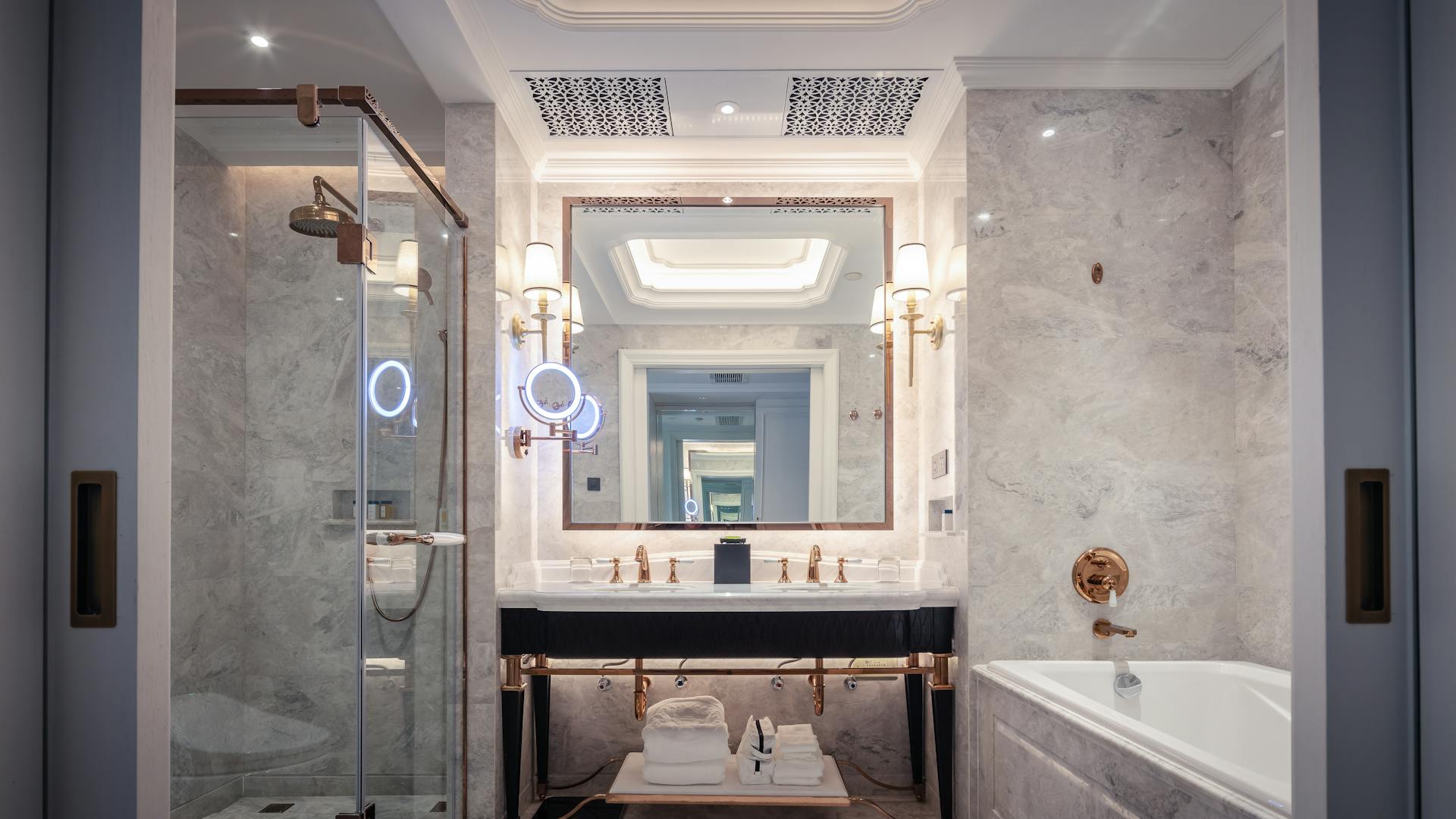
Lift chairs can be a game-changer for people with mobility issues, but the cost can be a barrier for many. Many insurance plans do cover lift chairs, but it depends on the type of coverage and the individual's needs.
Some insurance plans, like Medicare, may cover lift chairs as a medical necessity for people with certain conditions. For example, if you have arthritis or multiple sclerosis, your Medicare plan might cover a lift chair to help with mobility.
Typically, insurance companies require a doctor's prescription for a lift chair, and the chair must meet certain medical criteria. This ensures that the lift chair is a necessary medical expense rather than a luxury item.
Insurance coverage for lift chairs often varies by plan, so it's essential to review your policy and consult with your insurance provider to determine what's covered.
For another approach, see: Does Insurance Cover Arm Lift Surgery
Cost and Eligibility
Medicare typically only covers the seat lifting mechanism part of a lift chair, not the entire chair itself.

You'll pay 20 percent of the Medicare-approved amounts for the lift chair if you buy from a supplier that accepts assignment, after paying the annual deductible.
Medicare Part B will cover 80% of the cost of the motorized lifting device, and you'll pay the remaining 20% coinsurance out-of-pocket.
To be eligible for lift chair coverage, you must have Medicare Part B or a Medicare Advantage plan, and purchase a chair from a Medicare-participating supplier that accepts assignment.
You'll need a doctor's prescription for a lift chair, and your doctor will also need to complete the Certificate of Medical Necessity CMS-849, the Seat Lift Mechanisms form.
Here's a breakdown of the costs you may incur:
- Annual deductible for Medicare Part B: $240 in 2024
- 20% coinsurance for the lift chair: varies depending on the supplier and state you live in
- Cost of the chair itself: hundreds to thousands of dollars, depending on factors like reclining and special features
Cost
The cost of a lift chair can be a bit confusing, but let's break it down. Medicare typically only covers the seat lifting mechanism part, not the entire chair itself.
The reimbursement amount from Medicare varies by state, but it's usually around $300. You'll have to pay the rest out-of-pocket.

If you buy a lift chair from a supplier that accepts assignment, you'll pay 20 percent of the Medicare-approved amount after paying the annual deductible.
Medicare Advantage plans have the same coverage as Original Medicare, but out-of-pocket costs may vary between plan providers.
The cost of a lift chair itself can range from hundreds to thousands of dollars, depending on factors like whether it's reclining, the manufacturer, and any special features.
Here's a rough estimate of what you might pay: if Medicare covers 80% of the cost of the motorized lifting device, you'll pay 20% coinsurance out-of-pocket, plus the cost of the chair itself.
Typically, you'll pay around $350 for the lifting mechanism of the lift chair after Medicare pays their portion.
For more insights, see: Insurance Cover Breast Lift
Who Is Eligible?
To be eligible for lift chair coverage, you must have Medicare Part B, which is medical insurance, or a Medicare Advantage plan.
You'll need to talk to your insurer about costs, suppliers, and coverage rules if you have a Medicare Advantage plan.
Additional reading: Advantage Dental Insurance Oregon

To qualify, you must purchase a chair from a Medicare-participating supplier that accepts assignment.
A doctor's prescription is required for a lift chair, and you may need to pay a coinsurance or copayment for doctor's visits.
The doctor must also complete the Certificate of Medical Necessity CMS-849, which is the Seat Lift Mechanisms form, when prescribing a lift chair.
Medicare Coverage
Medicare covers the medically necessary part of a lift chair, which is the mechanism that moves the chair. This means that the plan covers the lifting mechanism, but not the chair itself.
To be considered medically necessary, a doctor must indicate the chair for the patient's specific health condition. This is crucial for getting approval from Medicare.
The patient's ability to stand, walk, and perform daily activities is taken into account when determining medical necessity. If the patient can transfer from the lift chair directly to a wheelchair, Medicare may not approve the lifting mechanism.
Here's an interesting read: Life Insurance That Covers an Insured's Whole Life

Medicare pays 80% of the lifting mechanism, leaving the beneficiary to pay the remaining 20%, plus the cost of the seat portion of the lift chair. The beneficiary must also pay the Part B deductible.
Here's a breakdown of the costs:
- Lifting mechanism: typically around $350 after Medicare pays its portion
- Part B deductible: varies
- Additional costs: fabric, cushion, and accessories (not covered by Medicare)
Medicare supplement insurance, also called Medigap, can help pay for some out-of-pocket costs relating to the purchase of a lift chair. However, current Medigap plans are unable to assist with the Part B deductible.
Buying and Certification
To buy a lift chair, you'll typically pay upfront and then get reimbursed by Medicare. Medicare-participating DME suppliers usually file a claim on your behalf.
Make sure the supplier you choose accepts Medicare assignment, as this will save you money. If they don't, you'll pay 100% of the cost.
Your primary care physician must provide a prescription for the lift chair, which will require completion of Form CMS-849 and submission to CMS.
Check this out: Does Insurance Cover False Teeth
Certification of Medical Necessity for Seat Mechanisms

To get certified for a seat lift mechanism, you'll need a prescription from your primary care physician. This prescription will serve as proof that the lift chair is medically necessary.
Form CMS-849 must be completed and submitted to CMS as part of the certification process. This form is a crucial step in getting your seat lift mechanism covered by Medicare.
If you don't purchase a chair through a Medicare-approved supplier, Medicare won't cover the lifting mechanism. This means you'll need to find a supplier that's on Medicare's approved list.
Here's an interesting read: Bcbs Dispute Form
Buying a Chair
If you need a lift chair, visit Medicare.gov to find a supplier that accepts assignment, or the Medicare-approved amount as full payment for covered services.
To do this, enter your zip code and select the “Seat Lift Mechanisms” category, then search through the directory of suppliers with an “M” symbol, indicating they accept Medicare assignment.
If you have Medicare coverage through a Medicare Advantage Plan, follow your plan’s guidelines for approval and purchase and call your plan’s customer service number to ask about steps for coverage of a patient lift chair mechanism.

You can also ask your healthcare provider for a list of local approved suppliers or check with your local Social Security office for updated listings.
Medicare-participating DME suppliers usually file a claim on your behalf, but if you buy a chair through a non-participating supplier, you'll pay 100% of the cost.
Typically, people pay for a lift chair upfront and then receive reimbursement from Medicare.
Sources
- https://www.lifewaymobility.com/blog/does-insurance-cover-stair-lifts/
- https://www.medicare.org/articles/will-medicare-pay-for-a-lift-chair/
- https://www.medicalnewstoday.com/articles/medicare-coverage-lift-chair
- https://www.medicarefaq.com/faqs/medicare-coverage-for-lift-chairs/
- https://myplanadvocate.com/does-medicare-cover-lift-chairs/
Featured Images: pexels.com


